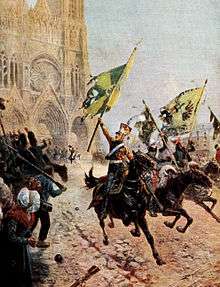Battle of Reims (1814)
| Battle of Reims | |||||||
|---|---|---|---|---|---|---|---|
| Part of War of the Sixth Coalition | |||||||
 "The Last Victory", by Maurice Orange, 1814. | |||||||
| |||||||
| Belligerents | |||||||
|
|
| ||||||
| Commanders and leaders | |||||||
|
|
| ||||||
| Strength | |||||||
| 20,000 | 14,000 | ||||||
| Casualties and losses | |||||||
| 700 |
Russians: 1,400, 12 guns Prussians: 1,300, 10 guns | ||||||
The Battle of Reims was fought at Reims (France) on 13 March 1814 between the French Empire and a Russian-Prussian force. The French, led by Napoleon Bonaparte, were victorious.
Background
The engagement took place during the 1814 campaign. After Napoleon had retreated from Russia and lost the Battle of Leipzig, the allied armies had invaded France. Napoleon won a number of victories (such as the battle of Reims), but had little chance of success, with just 70,000 men against half a million allied forces. The campaign ended with the allies taking Paris on 31 March and Napoleon's abdication on 6 April.
The battle
On 12 March, General Emmanuel de Saint-Priest had taken the city of Reims with 15,000 men. Napoleon responded by heading east from Soissons with 10,000 men and retaking the city the next day. Some 3,000 allied soldiers fell in the battle, and St. Priest was mortally wounded.
In a letter to his brother Joseph on 14 March, Napoleon wrote: "Yesterday I arrived in Reims, which had been occupied by General St. Priest with three Russian divisions and a new Prussian division. I captured the city, taking twenty guns, plenty of baggage, and 5,000 prisoners. General St. Priest has been mortally wounded".
Napoleon entered Reims at 2 a.m. while the allied forces fled through another city gate. The allies retreated to Laon, where St. Priest died two weeks later.
Historian Digby Smith wrote that French casualties in the recapture of Reims were about 900. The Russians lost 1,400 men and 12 guns, while the Prussians suffered casualties of 1,300 men and 10 guns. Saint-Priest's 8th Corps counted 7,800 men in the 11th and 17th Russian Infantry Divisions and the 1st and 4th Russian Dragoon Divisions. There were 5,600 soldiers in Friedrich Wilhelm Christian Ludwig von Jagow's brigade of the 2nd Prussian Corps. Smith did not list the total number of French troops engaged, but noted that Marshal Auguste Marmont's corps, Louis Friant's division, the Guard cavalry, and the I Cavalry Corps were involved in the battle.[1]
Napoleon had achieved a remarkable victory with troops whose morale had suffered due to heavy casualties and the defeats at Craonne and Laon. According to the historian F.W.O. Maycock, success at Reims was "surely one of the greatest triumphs of [Napoleon's] remarkable career, and speaks volumes for his powers as a leader of men".[2] Napoleon once again interposed between the forces of Blücher and Schwarzenberg, putting him in position to move on the latter's line of communications. Reims would be Napoleon's final victory in the Campaign of 1814.[3]
See also
Notes
- ↑ Smith 1998, p. 511.
- ↑ Maycock 2008, p. 103.
- ↑ Maycock 2008, p. 104.
References
- Maycock, F. (2008). Invasion of France, 1814: The Final Battles of the Napoleonic First Empire. Leonaur. ISBN 978-1-84677-579-6.
- Smith, Digby (1998). The Napoleonic Wars Data Book. London: Greenhill. ISBN 1-85367-276-9.
External links
Coordinates: 49°15′46″N 4°02′05″E / 49.2628°N 4.0347°E